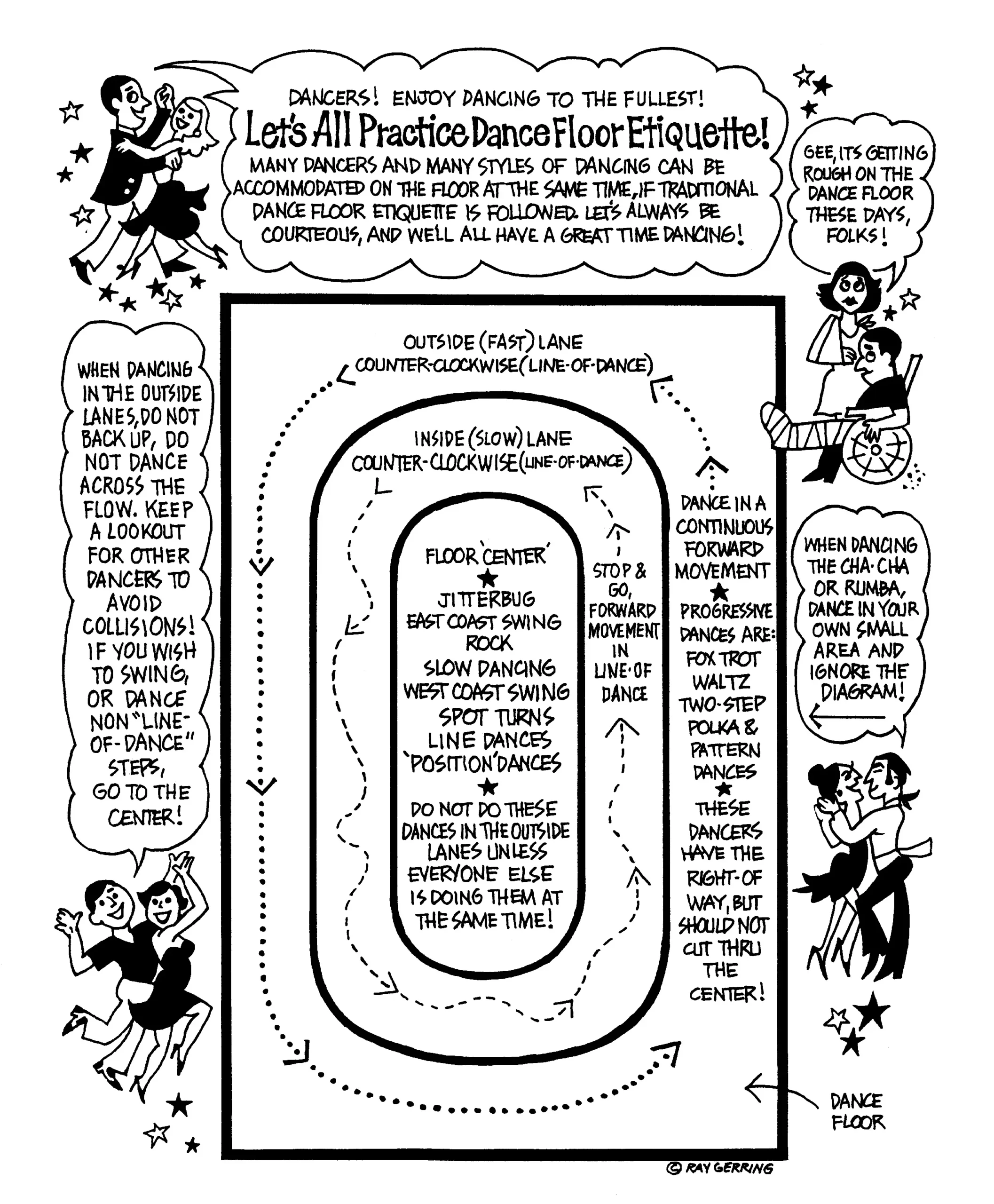Dance Etiquette
Home / Dance Etiquette
Keep Calm and Dance On
Dance Etiquette
Summary
Your outfit and accessories should be comfortable and safe.
Make sure your hygiene is conducive to close contact.
Be considerate and polite when you ask someone to dance–make sure you have eye contact with the person you are asking.
Please do not decline a dance unless it’s absolutely necessary, in which case, it is polite to sit out the rest of that dance.
Dancing with various partners at all levels of expertise and not monopolizing anyone benefits both new and advanced dancers.
Be considerate of other dancers and follow the rules of the dance floor.
Dance to the level of your partner and don’t offer unsolicited “pointers” unless asked
The Dance Floor Line of Dance
- Dancing is done in a counterclockwise direction along the floor, known as the Line of Dance. This applies to traveling dances including Waltz, Foxtrot, Tango, Samba, etc. Stationary dances–like rumba, salsa, and swing–require little across-the-floor travel and do not have a line of dance. West Coast Swing is danced in a slot, so try to match the same slot as the majority of the other dancers on the floor. General rule: the slower you are moving, the closer to the center of the floor you should be.
Entering/exiting the dance floor
- Exercise caution when entering/leaving the dance floor. It is the responsibility of the couple that is entering/leaving to make sure that they stay out of the way of couples that are dancing.
What to Wear!
Dance Shoes: Highly recommended for comfort and performance. Affordable options (starting at $30) are available online. If you don’t have dance shoes, opt for leather-soled shoes—avoid rubber soles to prevent injury. Do not wear strapless sandals, flip-flops, or slide shoes.
Clothing: Wear comfortable, well-fitted clothes that allow free movement while dancing (arms overhead, spinning, etc.). Avoid overly tight, loose, or restrictive clothing. Examples to avoid: flowy/baggy sleeves (partner can end up sticking their arm in your shirt by accident), strapless dresses/tops (they can slip down when you lift your arm to turn or dip), tops with straps that fall off the shoulder, too tight or oversized shirts/tops, full skirts that flare excessively during spins or ride up, tight skirts that don’t allow for full-length strides, floor length dresses (catch on shoes and tear), flowy pants legs (catch of shoes and tear or trip you), etc.
Dance shorts: dance shorts are highly encouraged under shorter skirts or skirts that flare when spinning.
Fitness dresses: Tennis skirts and tennis dresses frequently have built in shorts and a sports bra, paired with a fun belt and some cute jewelry are extremely functional for dancing.
Fitness undershirts: Fabrics that wick away sweat will help you feel cooler and drier during dancing.

Casual/Dressy clothing: Wear whatever makes you feel good dancing, anything from yoga pant, jeans, to fancy attire is acceptable.
Jewelry: Avoid large or bulky jewelry that could cause injury or get caught on you or your partner’s clothing while dancing.
Nails: Keep nails trimmed or filed to prevent scratches.
Personal Hygiene
Shower & Deodorize: Freshen up with a shower and deodorant/antiperspirant before dancing.
Oral Care: Brush your teeth and use mouthwash or a breath mint.
Food: Avoid strong-smelling foods (like onions or garlic) right before dancing.
Fragrance: Skip strong perfumes, colognes, or aftershave.
Avoid Alcohol & Cigarettes: Steer clear of them before and during the event.
Mints: Keep breath mints handy if you snack during the event.
Dancing = Exercise, So Be Prepared!
Stay Dry: If you sweat a lot, bring a small towel or extra shirt to stay comfortable.
Check for Sweat Marks: Wet your clothing ahead of time to see if it shows sweat stains. If it does, choose something else to avoid visible rings.
Stay Fresh: Use makeup for a dewy look or sweat-absorbing lotions and wipes to reduce shine.
Don’t Stress: Sweating is part of the fun! Most dancers are understanding, so relax—it just means you’re enjoying yourself!
Asking for a Dance
Anyone Can Ask: Either men or women may ask a partner for a dance. Our club welcomes individuals of any gender to assume either lead or follow roles, as they wish, so it is okay to invite someone to dance with a clear indication of what role you intend to take by saying “Would you like to dance? I will lead [or follow].” It is very common for more experienced dancers to assume the opposite role of leading or following as a means to improve their overall dance skills. (i.e. a woman leading or a man following).
Make eye contact: To avoid confusion, ensure you make eye contact with your intended partner.
Respect Conversations: If someone is talking, wait for them to make eye contact before asking to dance. If they don’t make eye contact with you, ask later.
Be Proactive: Don’t wait to be asked—go around and invite others to dance.
Signal Readiness: If you are interested in dancing, standing (not sitting) on the perimeter of the dance floor and attempting to make eye contact with people conveys that you are ready and willing to accept a dance invitation.
Simultaneous Requests: If two people ask you at once, choose one and offer to dance with the other later.
Limit Consecutive Dances: Avoid asking the same partner for more than two dances in a row unless you’re attending as a couple.
Rotating Partners Improves Your Dance Skills: Mix up your partners to help both less experienced and skilled dancers improve. This allows those with less experience to learn from the more experienced dancers. This allows for more experienced dancers to refine their lead or follow skills with someone who is not as experienced or practice their basics with the best technique they can.
Volunteer Teachers: Our teachers are volunteers who donate their time to our club. They are not required to dance with everyone. Feel free to ask, but they can decline or choose their partners.
Declining a Dance
You’re encouraged to accept most dance invitations, but here are acceptable reasons to decline:
You don’t know the dance (and don’t want to learn it).
You need a break or restroom.
You’ve already promised the dance to someone else.
You have an injury
If you decline, it’s polite to sit out the entire song. Dancing with someone else after turning down an invite is rude.
If someone repeatedly disregards etiquette—such as unsafe dancing, poor hygiene, or violating boundaries—a simple “No, thank you” is perfectly fine. Offering a brief reason is appreciated.
Consideration for your Dance Partner
Social dancers strive to make their partners comfortable and help them enjoy the dance. Be sensitive–it’s usually easy to detect your partner’s likes and dislikes and if in doubt, ask.
Lead and follow skills are essential to successfully executing a social dance. It is a common myth that if that it’s all about the lead. A great leader will struggle to lead someone who does not know how to follow. It takes two to tango (or salsa, or cha cha, or waltz)…. Social dancing in combination with private lessons where the instructor is focusing on teaching you lead and follow skills is the best way to improve your lead or follow skills and increase the comfort of your social dances.
The more experienced partner should dance to the level of the less experienced partner. If you are a leader, start with simple figures when dancing with a new partner, and gradually work your way up to more complicated patterns if your partner is demonstrating that they can follow. Experienced followers should try to connect with the leader to make it easy for them to see what it feels like to dance with a skilled follower. Let the less experienced leader gain confidence in leading basic patterns and you can focus on styling your basics with arm flourishes or excellent technique in your footwork.
If you are dancing in the role of follower, do not back lead unless your partner asks you to show them how to execute a step. Back leading in social dancing inhibits the leader from leading, it disrupts the intended dynamics of the dance, undermines the trust between partners, and inhibits the lead-follow connection necessary for smooth and enjoyable dancing.
Almost everyone has a past or current injury they are trying to protect. Go easy in the beginning and test them out first, or even better, get verbal agreement before trying things like dips and drops. Never assume that your partner has the flexibility, balance, or confidence to perform all your fancy tricks.
Keep your hands away from your partner’s “no zones” (breasts, buttocks, etc…) and keep their hands away from your “no zones.” Dancing involves physical touching and some dances are more sensual than others, but you should always check with your partner before pulling them in very close to you, even if the “traditional” way the dance is danced is very close. If you feel the partner pulling away from you, it is a sign that they are not comfortable with dancing that closely and you should either allow for more space or ask them if they would like some additional space when dancing. If you accidentally brush your partner’s breasts or buttocks while executing a dance move, please apologize and let them know it was unintentional.
Close contact should only happen on the dance floor, once the dance is over, please resume typical socially acceptance space between you and other people.
Protect your partner from impending collision. If a collision should occur, apologize to the other party, regardless of fault. Check your partner for injury. If an injury occurs, escort your partner off the floor, and tend to their needs.
If you realize that you are dancing off time, it’s okay to stop and check in with your partner on the count together and start again. Please do not keep dancing off time.
After the dance is finished and before parting, thank your partner, but don’t keep them talking after the dance is over unless they seem inclined to chat. Please exit the dance floor if you are going to have a longer conversation than just thanking them for the dance.
Feedback and Mistakes
Improvisation means that no dance will ever be the same. Variety is refreshing, and mistakes should be welcomed as opportunities to create something new.
Please be cautious about offering “pointers” to your dance partner unless s/he requests them.
· Try to avoid any version of the phrase, “You’re not supposed to do it that way” or “You are doing that wrong” unless the person is asking for your help executing a move. If you can’t refrain from saying something, it is better to recommend that they work with a professional for advice on the move instead of you providing it.
· If you and your partner want to have a conversation about how to improve a particular move, move to the very edge of the floor so you are not in the way of others actively dancing.
· If you are uncomfortable or getting hurt while dancing with someone, please tell your partner what is hurting you and politely tell them what needs to be changed for your safety. No one intends to hurt their dance partner while dancing and they most likely have no idea that they are hurting you if you don’t tell them.
§ Mistakes happen, but they are of little consequence if you just move onto the next pattern. It is unnecessary and annoying to attempt a “failed” move repeatedly in an effort to “get it right” unless both partners expressly state they want to keep trying to do it.
§ Never blame a partner for missed execution of figures. Regardless of who is at fault when a dancing mishap occurs, both parties are supposed to smile and go on. If you feel you must apologize, a simple “Sorry” is usually all that’s necessary.
· If you want more individualized support with a particular pattern or technique, please schedule a private lesson with a professional instructor or arrange with a local studio to practice with your partner—a social dance party is not the appropriate time for this.

